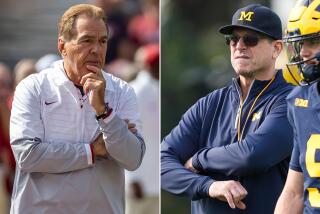‘Suntan U’ Tries to Shed Cushy Image
- Share via
CORAL GABLES, Fla. — Chances are excellent you’ve heard of the University of Miami’s football Hurricanes, 37-0 and vying for their second national championship in a row. But what of senior Devi Sridhar, who won’t be suiting up to play in today’s Fiesta Bowl?
The UM biology major, who is also a violinist, tennis player, author of a children’s book on Indian myths and speaker of five languages, is one of the latest crop of Rhodes scholars. At just 18, the senior is the youngest Rhodes laureate in American history.
“We’ve got another couple dozen like her that we’ve both been able to recruit and retain,” boasted Donna E. Shalala, the university president. “And we’re recruiting another two dozen in the freshman class.
“We’re hot for undergraduates,” Shalala said. “People who got in two years ago couldn’t get in today. There is a buzz about us.”
Just a little over three-quarters of a century old, the University of Miami was long labeled, maybe a little enviously, “Suntan U” -- a hard-partying place where the sun was warm and the studies not too trying.
For years, though, Miami has been striving to better its academics and its reputation, and Shalala, a former Cabinet official installed as president 1 1/2 years ago, plans another great leap forward in the coming months.
“I was hired by the trustees to make the university better, the best it could be,” said Shalala, speaking by telephone from Tempe, Ariz., where her school’s team will defend its national football title today against the Buckeyes of Ohio State University. “We want to hire distinguished new faculty, provide scholarships for bright students from around the country, endow chairs.”
Building the Best
Shalala’s detailed blueprint to elevate the 15,000-student private university will be made public this year, as part of a fund drive that she hopes will raise hundreds of millions of dollars.
“There are no secrets to building a first-class university,” said Shalala, who served as secretary of Health and Human Services in the Clinton administration. “You hire first-class people, you make sure they have the resources they need and the strategy to improve.” It is, she notes, uncannily like building a championship college sports program.
For some observers of academe, what Shalala and her staff dream of accomplishing on this palm- and banyan-shaded 260-acre campus in the Miami suburb of Coral Gables is reminiscent of the transformation of another institution that was once more reputed for excellence on the gridiron than in the classroom: the University of Southern California.
“At USC, the joke in the 1970s was that they were seeking an academic program the football team could be proud of,” said Paul Kanarek, who runs the Irvine office of the Princeton Review, which helps students prepare for standardized college admissions tests. By the 1990s, he said, USC had succeeded.
Right now, “Miami is sort of a middle-of-the-road school. I could not tell you the name of a single academic program there, other than the football program,” Kanarek said. The goal of the Shalala administration, he said, might be summed up in a term borrowed from the jargon of college admissions professionals: achieving “sweatshirtitis.”
“You want parents to wear the University of Miami sweatshirt with pride, and to say, ‘My kid is in the history department, and it’s hard to get into,’ ” Kanarek said.
Before joining the Clinton administration, Shalala, 61, was the first woman to head a Big Ten school, the University of Wisconsin at Madison. At Miami, she has been able to build on the accomplishments of predecessor Edward “Tad” Foote II, who in his 20-year tenure did much to make the erstwhile “Suntan U” more respected for its research and academics.
A Unique Location
In Shalala’s vision, UM’s medical program, already well-regarded, will become one of the nation’s best within 10 years. The university, which offers what may be the country’s only master’s of business administration program taught solely in Spanish, plans to use Latin America even more heavily as a recruitment pool and for job placement. Shalala is keen on exploiting Miami’s position as a bridge to the Southern Hemisphere and one of America’s Latino capitals.
Shalala aims to strengthen programs on aging, a major concern in Florida because of its retiree population. The school also recently announced the creation of a research center on breast cancer, and will open a 7,000-seat basketball arena Saturday.
Last autumn, $111 million worth of construction was underway at the main and two satellite campuses, and building projects worth more than that were in the planning and design stage.
The university has also been on the move to snare what Shalala called “the next generation of faculty leaders.”
Her first senior academic appointment, cellular biologist James H. Wyche, spent 14 years on the faculty at Brown University, considered one of the nation’s top schools. Now dean of UM’s College of Arts and Sciences, Wyche has long been active in trying to recruit African Americans and other minorities into the sciences.
In the diversity of its student body, Miami already may be a national leader, Shalala said. “We probably have the highest percentage of Hispanic medical students outside of Puerto Rico,” she says.
And what other university in the United States, she asks, has fielded an offensive line in football that spoke a total of 11 languages?
In the annual U.S. News & World Report rankings of American colleges, Miami was last rated as one of the country’s “second-tier universities,” that is, not among the top 50 schools.
“You can’t compare it with Berkeley or UCLA from an academic point of view, but as far as I’m concerned, they are getting close,” said Pong Srisanit, 27, a graduate student in electrical engineering from Thailand. “They are improving the academic level.”


